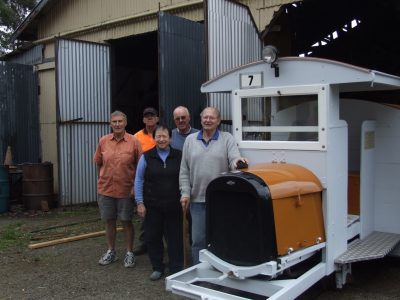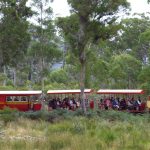Ida Bay Railway… one of the Great Rail Experiences in Tasmania
by Carol Haberle
Ida Bay Railway
Convicts & Immigrants: Pioneers of Ida Bay
The historical Ida Bay Railway is a ‘must do’ experience. Located at Lune River, a comfortable two-hour drive south of Hobart, the Ida Bay Railway is the last operating bush tramway in Tasmania, also having the distinction of being the most southerlyrailway in Australia.
Lune River and Ida Bay were once historic settlements dating back to the convict era, when settlement of Tasmania (then Van Diemen’s Land) was still occurring. Prior to the railway, this area was surviving on the timber industry; richly forested, the timber was harvested. Records of the early pioneers are slowly being documented. Stories of families such as the Tylers, a man convicted of petty crime back in England, transported to Van Diemen’s Land around 1843 to serve 10 years punishment. When given his Ticket of Leave, he made his way to Ida Bay, and became one of the early settlers in the region, his trade in brickmaking and sawmilling.
Also of the Jaeger family, free German immigrants who made settlement at Jaegers Bay, fishing their livelihood. A young Alexander Jaeger Junior who in 1903, at 17 years of age married Christina Tyler, only 13 years old. Together they had 21 children, but sadly, of these 21 children, only 13 survived past the age of 1 month. One truly begins to realise how heartbreakingly tough were the times these pioneers survived. The area then a maze of tram lines, no roads had been built, the only method available to transport the timber and bricks to waiting ships in the Lune River Estuary was by tram.
Limestone: History of Rail Begins
The Ida Bay Railway, a two foot gauge line, was constructed in 1922. At this point in time, limestone was being quarried at a location south east of Lune River. Transported by rail, the bogie flat wagons were loaded by hand with limestone from the open faced limestone quarry, then transported on this historic line to waiting ships in the Lune River Estuary. The ships would then transport the limestone to Electrona, where construction of a carbide factory began in 1917, and shortly after the end of World War 1 the Electrona Carbide Works began production of carbide. From the limestone, carbide was produced, to be used in the manufacture of acetylene gas, and also a component in the steel industry. The first locomotive used at Ida Bay Railway was a steam locomotive, a 1906 Krauss. In 1937 a Hunslet steam locomotive replaced the Krauss.
The railway was extended in 1950 to Deep Hole Bay, the end of the line. By 1951, the last of the steam locomotives was retired. Five Malcolm Moore petrol locomotives began working the line, all ex-army locomotives built in 1943, carting the limestone, now machine loaded, to the wharf at Deep Hole Bay. Three to four ships per week left the area, all loaded with limestone for carbide production. The carriage of limestone eventually went to road trucks, and 1974 saw the last train loaded with limestone leaving Lune River. The end of an era for the Ida Bay Railway.
New Era for Ida Bay Railway
Ida Bay Railway was officially opened on the 20th December, 1977 to operate as a tourist attraction. Sadly, through lack of maintenance over the next couple of decades, the Ida Bay Railway became neglected and in 2002 was closed, considered unsafe. In January 2005 came new ownership and an intensive maintenance programme on the track, buildings and rolling stock saw a transformation begin to occur. Through passion, love and sheer dedication, the owner, employees and volunteers completely transformed this area. Today, Ida Bay Railway is open and fully functioning as a major tourist attraction, complete with Rail Safety Accreditation… a credit to all concerned.
Great Rail Experience
To travel on this lovingly restored Malcolm Moore petrol driven locomotive from Lune River to Deep Hole Bay is truly a unique experience. Aboard a bogie flat wagon built in the 1890s, lovingly restored as a passenger carriage, the two hour return trip features…
- forests
- buttongrass plains
- beautiful bay views
- so many historical points of interest
- aboriginal middens
- the site of the original Ida Bay township
- the remains of a river steamer now slowly being swallowed by nature
- an historic old cemetery where pioneers, the Tylers and the Jaegers, were laid to rest (a fascinating stop here)
Flora and Fauna: Unique
See all manner of Tasmanian fauna and flora: a pelican known to sit on the old boiler from the steamship SS Victoria in Ida Bay; cockatoos (both the sulphur crested and the yellow tailed black); sea-eagles, fairy herons and the rare Grass Parrot are all known to frequent the area. Kangaroos and wallabies are often sighted amongst the beautiful native flora. Christmas Bells, flowering tea trees, native orchids, ferns and so much more. All lead to Deep Hole Bay, where beautiful white beaches await a wander with magical views across the bay to Southport, where dolphins can be seen swimming in the bay at the right time of year.
One can arrange to take an early train ride down to Deep Hole Bay, spend the day amidst the beautiful surroundings and catch the last afternoon train back to Lune River Station. Deep Hole Bay, a part of the Ida Bay State Reserve, has a large shelter complete with BBQ facilities and toilets, so is a delightful area for a picnic. Or take a bushwalk along the walking tracks to Southport Lagoon or Southport Bluff, both accessible from Deep Hole.
Information, Memorabilia and Food
Either before or after your train trip, take the time to have a look around the Lune River Station and the Ida Bay Railway Café. You’ll meet Meg, a beautiful lady, whose love and passion for both the area and the railway has seen this tourist attractionbecome what it is today. There’s a goldmine of information and history of the surrounding areas. Oh, and Meg makes one of the best cappuccinos around, guaranteed! A wide selection of hot and cold food and drink is available. Here you can also order a BBQ pack if choosing to spend the day down at Deep Hole. Disabled toilets and wheelchair access are also available at the café.
Take the time to browse the memorabilia of this heritage railway at the Ida Bay Railway Ticket Office, where you will purchase your tickets.
In closing, I’d like to extend a very sincere thank you to Meg (you truly do make the best cappuccino), Mike (for taking the time to give us the valued history lessons) and Judd (the ride was awesome). And all that rain did not deter us, it truly added to the experience.
Ida Bay Railway is a year round tourist attraction. For further details and bookings contact via phone 0405 305 437 or email [email protected].
For more information, visit or follow the…
- Ida Bay Railway website
- Ida Bay Railway Facebook page
Carol and Kevin Haberle were guests on behalf of Think Tasmania and stayed overnight in the region at
- Woodbridge Hill Hideaway
All photos strictly ©Carol Haberle, H&H Photography. You can follow Carol on Facebook at Haberle Photo Cards. Carol writes feature articles for this website about all things Tasmanian. If you’d like Carol to visit you, please contact Think Tasmania.
If you like this article about Tasmania, and you’d like to read more, just subscribe to our newsletter or join us on social media via Facebook, Twitter, Pinterest or Instagram. If you really like this article, and you want others to see it, you can choose one of the “share” options below. We’d love that!
Comments relevant to this article are always most welcome, just leave a reply below. But first… please confirm the date of this article. Have you found something current, or is this ancient information? Either way, thanks for your company and come back again soon.
















